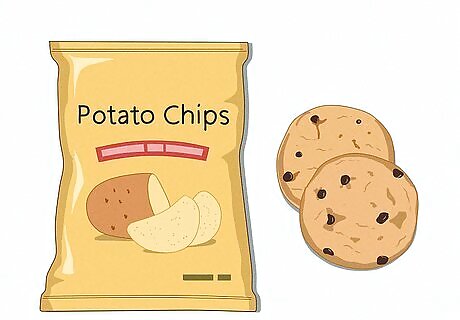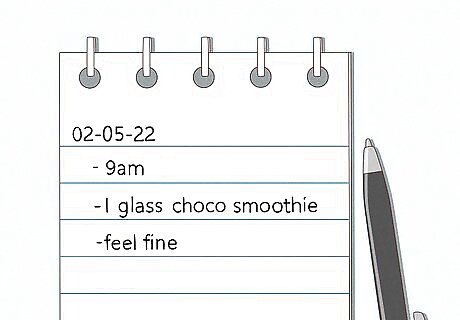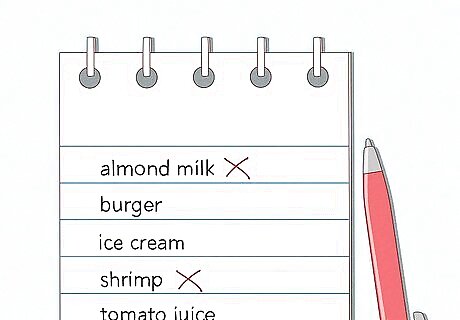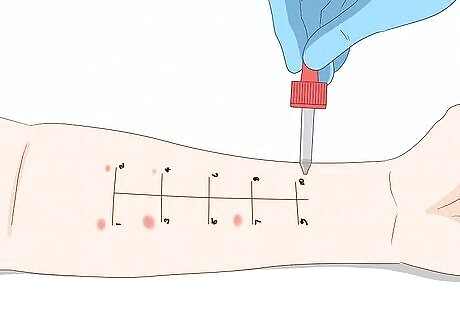
views
Common Trigger Foods

Fatty, sugary, and salty foods are potential overeating triggers. Try eating just 1 potato chip from the bag, or munching on a single cookie from the sleeve. It’s hard, right? Health experts agree that calorie-rich, unhealthy snacks and desserts are big trigger foods, as people tend to eat them in large portions. Processed foods may also trigger overeating. One study shows that people who eat processed foods are more likely to overeat, while people who eat whole, unprocessed foods are not as likely.

Lactose and fructose are major IBS triggers. Dairy products like milk, ice cream, and cheese are notorious triggers that lead to uncomfortable gassy symptoms. Fructose is another common culprit; unfortunately, it’s plentiful in both processed and unprocessed foods, including certain fruits, like pears and apples. Here are a few other IBS triggers you should be on the lookout for: Drinks: Anything carbonated and/or caffeinated Foods: Sugar-free gum, chocolate, broccoli, beans, and Brussels sprouts

Whole grains and high-fiber foods are triggers for Crohn’s disease. Fiber-rich foods are common causes of Crohn’s flare-ups—this includes whole grains and beans. Here are some other Crohn’s triggers to watch for: Drinks: Alcoholic and caffeinated drinks Foods: Seeds, nuts, artificial sweeteners, greasy food (burgers, fries, salami, sausage), spicy food, and dairy products (milk, cheese, ice cream) Some examples of whole grains are brown rice, rye, oats, millet, buckwheat, barley, and wild rice. Some popular beans you might run into are black beans, black-eyed peas, cannellini beans, garbanzo beans (chickpeas), kidney beans, and lima beans.

Greasy, fatty foods can trigger acid reflux. Unfortunately, fast food, pizza, bacon, sausage, cheese, potato chips, and fried food all make this list. These tasty snacks tend to slow down digestion, and stick around in your stomach for more time than they’re supposed to. Some other potentially problematic foods include: Chocolate Lemons, limes, and other citruses Peppermint Tomato sauce Carbonated drinks

Artificial sweeteners and MSG are common migraine triggers. A wide variety of different foods are associated with migraines, but it really depends on the individual. MSG and artificial sweeteners make the list, along with many other foods and ingredients, like: Alcohol: Whiskey, Scotch, champagne, red wine, and beer Foods: Peanuts, seeds, nuts, pizza, potato chips, organ meat, dried/smoked fish, sourdough bread, beans, avocados, pickled goods, dried fruit, chocolate, certain dairy products, and premade soups Ingredients: Nitrates, nitrites, caffeine, and Brewer’s yeast Keep in mind that only 1 in 5 migraines are actually connected to a trigger food. Some other factors can also contribute to migraines, like your family history.
Tracking Your Diet and Symptoms

Double-check the ingredient label before eating any food. Look for any ingredients that could possibly trigger a flare-up, and leave the food item on the shelf if you notice any suspicious ingredients. If you’re allergic to dairy, keep an eye out for ingredients like whey, lactose, dry milk solids, milk by-products, cheese, curds, butter, nonfat dry milk, and/or dry milk powder. If you’re sensitive to gluten, avoid ingredients like semolina, spelt, farro, farina, wheatberries, durum, emmer, graham, einkorn wheat, male, brewer’s yeast, wheat starch, barley, rye, and triticale.

Keep track of the food you eat in a daily food journal. Grab a blank notebook or journal and start jotting down your meals and snacks. Mention what you’re eating, what the portion size was, what time you ate, and how you felt at the time. Then, keep an eye out for patterns that pop up as you eat certain foods. You might notice that tend to overeat your favorite snack or dessert as soon as you get off work. You might get consistent flare-ups after eating dishes with a specific ingredient.

Figure out which foods bother you with an elimination diet. Jot down any foods or ingredients that seem to trigger flare-ups for you and remove these foods from your diet for multiple weeks. Then, test 1 trigger food at a time using the 3-day approach, where you gradually increase the portion of the problem food to see if it leads to a flare-up. Jot down your results in a notebook or journal, so you can keep track of your symptoms. Once you’ve gone through every item on the list, add the non-problematic back to your diet and see if you feel any better. During a 3-day approach, eat just a tiny portion on the first day. If you don’t notice any flare-ups, eat a slightly bigger portion on the second day. If you still feel okay, eat a standard portion of the food on the third day. If you notice any symptoms or flare-ups on the first or second day, stop the trial period short and move on to the next food item on the list. Just be sure to note which foods bothered you. Once you’ve finished a 3-day approach for a trigger food, completely remove it from your diet again. Then, test another problem food for 3 days. Don’t add anything back to your regular diet until you’ve gone through every food or ingredient on your list.

Meet with an allergist or nutritionist to address your food intolerances. An allergist can perform a blood test or skin prick to check for certain food intolerances and allergies. Once you know what your food intolerances are, meet with a registered dietician nutritionist, who can help you come up with a safe, healthy diet that won’t lead to any flare-ups. Your regular doctor can refer you to an allergist and nutritionist. Meeting with a qualified professional is much more helpful than taking a food sensitivity test. Food sensitivity tests aren’t supported by much medical evidence and aren’t a credible, reliable way to figure out what your trigger foods are.


















Comments
0 comment